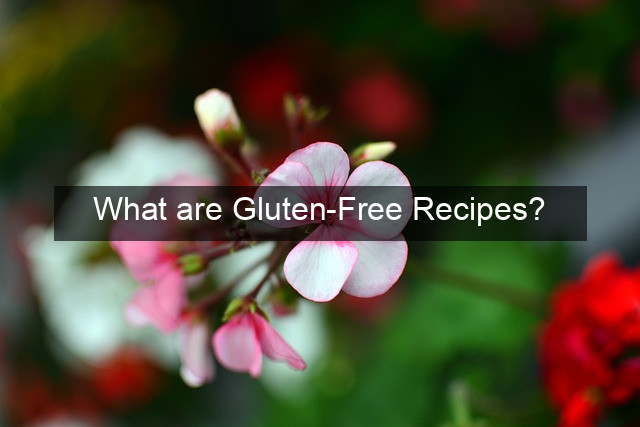What are Gluten-Free Recipes?

- What are Gluten-Free Recipes?
- What are Gluten-Free Recipes?
- Understanding Gluten and its Impact
- Why Go Gluten-Free?
- Identifying Gluten in Foods
- Embracing Gluten-Free Alternatives
- Creating Delicious Gluten-Free Meals
- Breakfast Ideas
- Lunch and Dinner Recipes
- Gluten-Free Baking Tips
- Navigating a Gluten-Free Lifestyle
- Dining Out Gluten-Free
- Grocery Shopping Strategies
- Gluten-Free on a Budget
- Conclusion
- Frequently Asked Questions

What are Gluten-Free Recipes?
Imagine a world where bread, pasta, and your favorite baked goods are suddenly off-limits. For individuals with celiac disease or gluten sensitivity, this is a daily reality. Gluten-free recipes provide a pathway back to enjoying these foods, offering delicious alternatives that cater to specific dietary needs. But what exactly does “gluten-free” mean, and how can you incorporate these recipes into your life? Gluten-free cooking involves omitting gluten, a protein found in wheat, rye, and barley. This seemingly simple change opens a door to a world of culinary exploration, using alternative flours and grains to create dishes that are both flavorful and safe for those with gluten intolerances. From savory main courses to decadent desserts, the possibilities are endless. This guide delves into the world of gluten-free cooking, offering insights, tips, and inspiration for embracing a gluten-free lifestyle.
Understanding Gluten and its Impact
Why Go Gluten-Free?
Celiac disease is an autoimmune disorder triggered by gluten consumption. Even small amounts can damage the small intestine, leading to nutrient deficiencies and long-term health complications. Gluten sensitivity, while not an autoimmune disease, can cause similar digestive discomfort, fatigue, and other symptoms. Adopting a gluten-free diet is crucial for managing these conditions and improving overall well-being.
Beyond medical necessity, many individuals choose a gluten-free lifestyle for perceived health benefits, such as increased energy and improved digestion. While research on these benefits is ongoing, the growing popularity of gluten-free diets has led to a wider variety of readily available gluten-free products and recipes.
Choosing to go gluten-free requires careful planning and label reading to avoid hidden sources of gluten. Cross-contamination can also be a concern, so dedicated cooking utensils and preparation areas are often necessary to prevent accidental gluten exposure.
Identifying Gluten in Foods
Gluten hides in many unexpected places. Obvious culprits include wheat-based products like bread, pasta, and cereals. However, gluten can also lurk in sauces, processed meats, and even some medications. Carefully scrutinizing ingredient lists is paramount for those following a strict gluten-free diet.
Common hidden sources of gluten include malt flavoring, modified food starch, and soy sauce. Learning to identify these hidden sources is essential for navigating the grocery store and dining out safely.
Look for certified gluten-free labels, which indicate that a product meets specific standards for gluten content. This certification provides an extra layer of assurance for consumers seeking gluten-free options.
Embracing Gluten-Free Alternatives
The good news is that the gluten-free market has exploded in recent years, offering a plethora of alternatives to traditional wheat-based products. Gluten-free flours made from rice, almond, coconut, and tapioca offer diverse textures and flavors for baking.
Experimenting with different gluten-free flours can be a culinary adventure. Each flour has unique properties, so understanding their characteristics is key to achieving desired results in baking.
Beyond flours, a wealth of naturally gluten-free grains and starches, such as quinoa, amaranth, and buckwheat, can add nutritional value and variety to your diet.
Creating Delicious Gluten-Free Meals
Breakfast Ideas
Starting your day with a satisfying gluten-free breakfast is easier than you think. From fluffy pancakes made with almond flour to hearty oatmeal with fruit and nuts, the possibilities are endless.
Consider incorporating eggs, yogurt, and smoothies into your breakfast routine for quick and nutritious gluten-free options.
Pre-made gluten-free breakfast cereals and bars are also convenient choices for busy mornings.
Lunch and Dinner Recipes
Gluten-free lunches and dinners can be just as flavorful and satisfying as their gluten-containing counterparts. Explore cuisines that naturally rely on gluten-free ingredients, such as Asian stir-fries, Mexican tacos with corn tortillas, or Mediterranean salads.
Get creative with gluten-free pasta made from rice, corn, or quinoa. Pair it with your favorite sauces and vegetables for a complete meal.
Don’t forget about protein! Grilled meats, fish, poultry, and beans are all excellent additions to gluten-free meals.
Gluten-Free Baking Tips
Baking gluten-free can be challenging, but with the right techniques and ingredients, you can achieve delicious results. Gluten-free flours often require different ratios of liquid and binding agents compared to wheat flour.
Experiment with xanthan gum or guar gum to improve the texture and structure of gluten-free baked goods.
Don’t be afraid to try new recipes and adapt existing ones to suit your preferences and dietary needs.
Navigating a Gluten-Free Lifestyle
Dining Out Gluten-Free
Eating out can be tricky when you’re gluten-free. Communicate clearly with your server about your dietary restrictions and inquire about gluten-free options.
Many restaurants now offer dedicated gluten-free menus or are willing to accommodate special requests.
Research restaurants in advance to identify those with a strong reputation for catering to gluten-free diners.
Grocery Shopping Strategies
Navigating the grocery store can be overwhelming when you’re first starting a gluten-free diet. Familiarize yourself with gluten-free brands and products.
Dedicate a separate section of your pantry and refrigerator for gluten-free items to prevent cross-contamination.
Read labels carefully, even on products that appear gluten-free, as ingredients can change.
Gluten-Free on a Budget
Gluten-free products can be more expensive than their conventional counterparts. However, with careful planning, you can maintain a gluten-free diet without breaking the bank.
Focus on naturally gluten-free whole foods, such as fruits, vegetables, and lean proteins.
Cook at home more often and prepare meals in bulk to save money and reduce food waste.
| Gluten-Containing Ingredient | Gluten-Free Substitute |
|---|---|
| Wheat Flour | Rice Flour, Almond Flour, Coconut Flour |
| Breadcrumbs | Gluten-Free Breadcrumbs, Almond Meal |
| Soy Sauce | Tamari, Coconut Aminos |
- Always read labels carefully.
- Be mindful of cross-contamination.
- Experiment with different gluten-free flours and ingredients.
Conclusion
Embarking on a gluten-free journey can seem daunting at first, but with knowledge and preparation, it can be a rewarding experience. Gluten-free recipes unlock a world of culinary possibilities, allowing you to enjoy delicious and satisfying meals while prioritizing your health. By understanding the nuances of gluten-free cooking and embracing the wide array of available ingredients, you can create a fulfilling and flavorful lifestyle that caters to your specific dietary needs. Remember, going gluten-free is not about restriction; it’s about discovery. It’s about exploring new flavors, textures, and cooking techniques. It’s about taking control of your health and well-being through mindful eating. So, embrace the adventure, experiment with new recipes, and savor the delicious world of gluten-free cuisine.
Frequently Asked Questions
Q: What is the difference between celiac disease and gluten sensitivity?
A: Celiac disease is an autoimmune disorder, while gluten sensitivity is not. Celiac disease causes damage to the small intestine, while gluten sensitivity typically causes digestive discomfort and other symptoms.
Q: What are some common hidden sources of gluten?
A: Gluten can hide in malt flavoring, modified food starch, soy sauce, and certain medications.
Q: Where can I find gluten-free recipes?
A: Numerous cookbooks, websites, and blogs offer a wealth of gluten-free recipes.
Q: Is a gluten-free diet expensive?
A: It can be, but focusing on whole foods and cooking at home can help manage costs.
Q: How can I prevent cross-contamination in my kitchen?
A: Use separate cutting boards, utensils, and cooking surfaces for gluten-free foods.
Q: Are all gluten-free products healthy?
A: Not necessarily. Some gluten-free products can be high in processed ingredients and sugar. Choose




